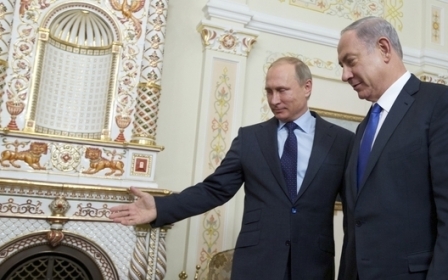The return of Russian imperial policy

Like most of the old world, the pre-modern Middle East and North Africa (MENA) region had its share of violence, destruction and wars. It may even have more than its share. Its temperate climate, diversity of resources and central location turned the region into a target for ambitious empires, adventurers, those obsessed with the delusions of divine preference and the migrations of nations and peoples.
However, since the crystallisation of the Islamic sociopolitical order, conflict and strife among the ruling classes were the source of much of this violence. Unlike the European continent, for instance, the MENA region did not know a wide scale or long lasting civil violence, nor did it know cases of genocide or mass deportation as those that were inflicted upon the Muslims and the Jews in Andalusia, or to what Catholic or Protestant groups suffered during the religious wars, or what the Jews suffered once more during the period the Second World War. What set the foundations during the Islamic era for social peace was the system described by the Ottomans as the Millet system.
The Ottomans were not the ones who invented this system, which guaranteed a sort of autonomy for religious and ethnic communities to manage their own affairs. What the Ottomans did is that they just gave the system a name and transformed it into an official institution with established norms. The fact is that the system of granting various communities the power to manage their own affairs, especially religious, legal and educational affairs, developed over many centuries in the aftermath of the early Islamic conquests. The Islamic legislative vision of political sociology may be considered the first brick in the edifice of this order.
Unlike the modern European notion of tolerance, which is founded upon the supremacy of the majority and its compassion toward minorities, Islamic legislation assumed right from the beginnings a primary right for non-Muslim communities to exist in the Islamic society. This, of course, does not mean that Islamic history did not witness cases of persecution and discrimination against non-Muslim minorities. However, those were rare and sporadic cases, such as the policy of discrimination adopted by the Fatimid al-Hakim Bi Amrillah against the Christians and Jews. In fact, al-Hakim Bi Amrillah pursued an arbitrary and repressive policy against all his subjects, including Muslims.
There is much debate today about the Millet system. Yet, its critics seem to ignore the fact that this system was the main reason behind maintaining the state of religious and sectarian pluralism in which the residents of the MENA region lived then and still do, and that it is the system that provided long-term protection for this pluralism from the assimilative trends. The idea of citizenship, which has become the global model of political sociology, is relatively a new development in human history. It is rooted in the French Revolution in the late 18th Century. It is worth noting that some of the religious communities in the MENA region - as in the case of the Coptic Church in Egypt for instance, which usually emphasises the value of citizenship - adopt in effect practices that are rooted in the Millet system, including the church's keen endeavour to represent the Coptic community and establish a parallel educational institution for their own children.
What matters is that the collapse of the Millet system, which started more than a century before the Ottoman Sultanate renounced it officially in the second half of the 19th Century, was accompanied by a state of eruption in civil violence. There are those who believe that such violence and the loss of stability are still with us to this very day. The dismantlement of the Millet system was associated with the escalation of global conflict over the MENA region and the birth of the European powers' policy of minorities' protection in the region, such as the Orthodox, the Catholics, the Maronites, the Jews and the Druze. The first European imperialist power to meddle with Ottoman communities was Tsarist Russia. The reason behind this is related to the origin of the Russian empire and its geographic location.
Orthodox Christianity began to spread within the space known today as Russia several centuries prior to the Ottoman conquest of Constantinople in the middle of the 15th century. Russian emperors saw themselves as the rightful inheritors of Byzantium and saw their own capital as the rightful inheritor of Constantinople and as the new Jerusalem. They adopted the title of Tsar, which was originally the title of the Byzantine emperor. During subsequent centuries, and despite the fact that the Ottomans continued to expand into Eastern and Central Europe, the Russian Tsars were busy reinforcing their imperial capabilities. The second half of the 18th Century, during the reign of Empress Catherine, saw the start of the lengthy and bitter confrontation between the Ottomans and the Russians, which only came to an end after the Ottoman collapse in the First World War.
In 1768, the Russian Baltic fleet navigated through the Strait of Gibraltar for the first time and fought a major sea battle inflicting heavy losses on the Ottoman fleet. Four years later, the Russian fleet bombed the Syrian coastal towns and the Russians occupied Beirut for a brief period of time in support of Ali Bec and Zahir Al-Omar in their war against the Ottoman authorities. That intervention marked the beginning of the Russian attempt to establish a permanent presence in the warm seas, seeking tirelessly to seize control of Istanbul and the Ottoman straits. Since the Russian move took a religious character right from the start, the Russians assumed for themselves the role of protectors for the Ottoman Orthodox communities in the Levant, in Anatolia and in the Balkans. The Russian Orthodox Church provided the ideological cover for the Tsarist wars. Such a role acquired some legitimacy toward the end of the Ottoman-Russian war in 1777 and with the signing of the Treaty of Kucuk Kaynarca, which granted the Russians control of the Crimean Peninsula and made them for the first time partners along the coast of the Black Sea and a role in Jerusalem. The fact is that the spark that ignited the Crimean war, which then developed into what resembles an international conflict and ended with the Russian defeat in 1856, was the outcome of a Russian-French (Orthodox-Catholic) dispute over the Church of the Holy Sepulchre in the City of Jerusalem.
By that time, the Western policy of minorities protection in the MENA region had become an established institution: the Russians on behalf of the Orthodox, the French on behalf of the Catholics, including the Maronites, and the British on behalf of the Druze and then the Jews. In that way, the historic oriental pluralism exploded in a series of civil conflicts that in turn undermined Ottoman social peace and weakened the Sultanate in the face of European powers.
What revives this memory today is the step taken by Moscow to militarily intervene in Syria and the support that President Putin has received from the Russian Church. As Moscow seeks to restore the glory of the past, the Tsar of Federal Russia sets his eyes once more on the south and on the warm seas. The Russian Church did not only extend its blessings to Putin just because it considered his Syrian intervention as a “holy war” but also to affirm that Russia's war in Syria is nothing but a manifestation of “the special role our country has always played in the Middle East”.
The problem with this new Tsarist-Church fusion is that relations of the majority of the Arab Orthodox Christians with their Muslim compatriots have throughout the past century been strong and cohesive. Despite the fact that the MENA region is witnessing deterioration in the relations between sects and ethnicities, nothing blemishes the relations of the Arab Orthodox Christians with the majority-Arab Sunnis. However, Russian President Vladamir Putin's policy in the MENA region, which is seen by many as a policy that supports sectarian hegemony (and perception is often more profound in its effect than reality), and the intervention by the Russian Church as to provide a religious and moral cover for this policy, may turn to be a major source of threat to Islamic–Orthodox relations.
- Basheer Nafi is a senior research fellow at Al Jazeera Centre for Studies.
The views expressed in this article belong to the author and do not necessarily reflect the editorial policy of Middle East Eye.
Photo: A Russian orthodox priest blesses a SU-27 SM fighter jet on the airfield of Belbek military airport outside Sevastopol on 26 November, 2014 (AFP).
Middle East Eye propose une couverture et une analyse indépendantes et incomparables du Moyen-Orient, de l’Afrique du Nord et d’autres régions du monde. Pour en savoir plus sur la reprise de ce contenu et les frais qui s’appliquent, veuillez remplir ce formulaire [en anglais]. Pour en savoir plus sur MEE, cliquez ici [en anglais].





